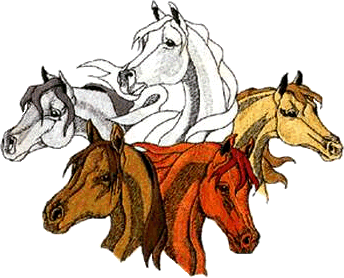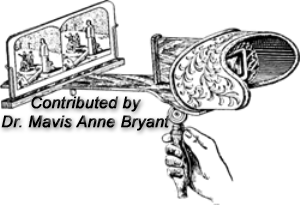Thomas
E. Horan, Harness Dealer
On the western frontier before the twentieth
century, transportation on land relied on horses, mules, buggies, carriages,
and wagons. In Denison, Texas, during its early years, Thomas E. Horan was a
major supplier of the equipment needed for such animals, and he also supplied
the vehicles they pulled.
Although data about Thomas's early life is somewhat
obscure, it seems probable that his parents were immigrants from Ireland, and
he may have been, too. If not, he was born in New York in August 1850. He
married Anna M. Gallaher in Jack County, Texas, on April 26, 1879. She seems to
have been born in April 1852 in New York.
The Denison City Directory did not list Thomas in
1876, but he was there by 1887, operating a harness shop at 202 West Main
Street. He lived at the same address.
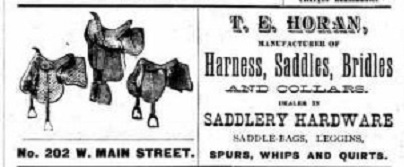
1887 Denison City Directory
T.E. Horan
202 W. Main Street
The combined harness shop and residence
were still there in 1891.
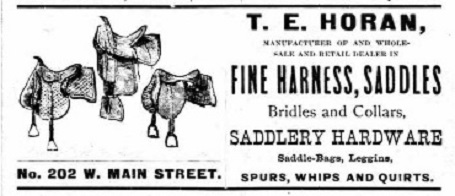
1891 Denison City Directory
T.E. Horan
202 W. Main Street
By 1896, according to City Directory, the Horans were
living at 610 West Munson Street, and the shop had taken over a space at
416–418 West Main Street.
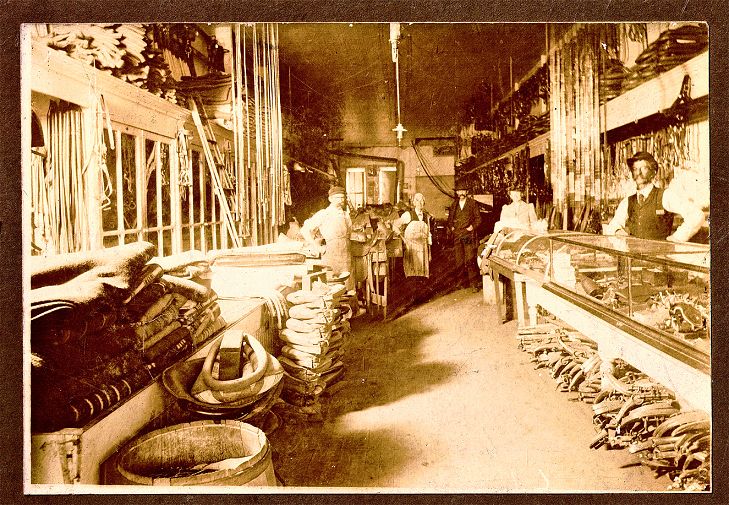
E. Horan Harness Shop, 1897
Charles H. Brigham, Manager
609 S. Armstrong Avenue
Denison. Texas
John Kesel, X Wright, Mrs. T.E. Horan, J.P. Coil
(Collection of Grayson County Frontier Village)
A photograph in the collection of Frontier Village
identifies the Horan Harness Shop at 609 South Armstrong Avenue in 1897. However,
that shop interior appears to be the same one depicted in a book published
around 1908, so perhaps the address was mistaken. In any case, the Horan
Harness Shop continued at 416 West Main until Thomas's death in 1905.
The 1900 Census found the Horans living at 418 West
Main, and Anna lived there for a time after her husband's death.
The 1901 City Directory described the Horan business : "Manufacturer, and dealer in
saddles, harness, saddlery hardware, carriages, buggies, wagons, etc."
Photographs published around 1908 showed three different aspects of the
business—a storefront with a white horse used as a trade sign, an interior
store chock full of merchandise, and a "buggy respository."
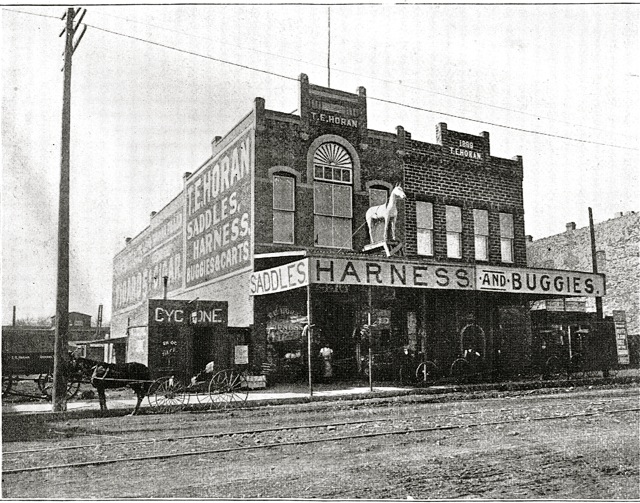
"T.
E. Horan, Wholesale Saddles, Harness, Buggies, Wagons, and Shoe Findings,
416
and 418 W. Main Street."
From Robinson, Frank M., comp. Industrial Denison.
[N.p.]: Means-Moore Co., [ca. 1909]. Page 102.
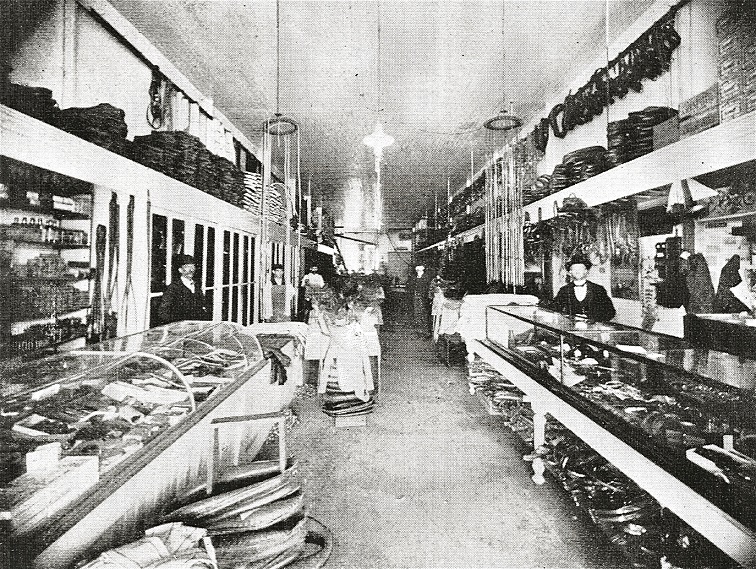
"T.
E. Horan, Interior of Retail Store,
416
- 418 W. Main Street."
From Robinson, Frank M., comp. Industrial Denison.
[N.p.]: Means-Moore Co., [ca. 1909]. Page 103.
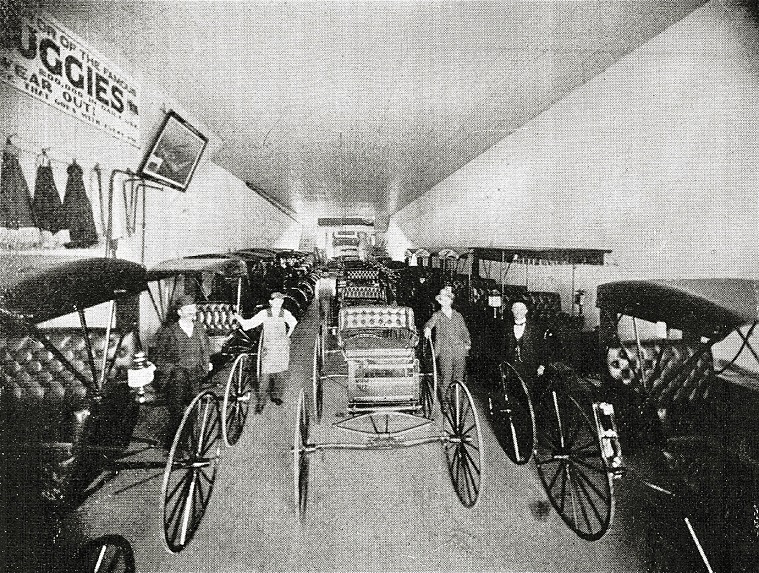
"T.
E. Horan, Interior of Buggy Shop Repository"
Probably 416 - 418 West Main
From Robinson, Frank M., comp. Industrial Denison.
[N.p.]: Means-Moore Co., [ca. 1909]. Page 103.
In
1903, Thomas Horan was listed in the City Directory as
"Councilman-at-Large," a demanding position, in addition to running
his business. Anna helped out in the store.
By
1905, Thomas was quite ill. Nevertheless, when friends decided to steer a
flat-bottomed boat east on the Red River, he was determined to join them for
the voyage. Sadly, he did not survive the trip.
* * * * *
Steamboat "Annie Peruna" Built
in Denison
By
Donna Hunt
[Source:
Sherman TX Herald Democrat, March 13,
2013]
A lot has been written through the years about the
Annie P., the first steamboat to navigate the Red River. It was early in 1905
that the Annie P. plowed up the river from New Orleans to Denison, proving the
Red River was navigable.
Now we learn that a Denison-built boat also had its
day on Red River a short time later.
What was intended as a whimsical, but not mocking
parody on the voyage of the Annie P., the Annie Peruna was built in Denison
later the same year and used on the river for a while. Bert Ford, one of
Denison’s earliest gasoline motor mechanics, and Lon McAleer, owners of a Sugar
Bottom coal and wood yard, were builders of the boat. An unbylined and undated
yellowed article clipped from The Denison Herald said “the two were always
ready for anything that broke away from the humdrum.”
Bert died in Denison and Lon died a few years later in
Red River County, where he had purchased a sizeable tract of land after he left
Denison.
The article said that the Annie P. probably was the
inspiration for the Annie Peruna, and the Denison builders undoubtedly took
their cue from the former in selecting a name for their 25-foot boat.
The Annie Peruna was powered by a one-cylinder
gasoline engine of early design that rotated the stern wheel that moved the
boat. It was built in town, then taken on house-moving blocks to the Colbert
crossing, where it was launched.
A picture taken by Carl Davault was taken as the boat
was being inched toward the river. The flat-bottomed craft drew only a few
inches of water and could negotiate the sallow stretches of the river with
pretty good safety. The boat was christened by the two builders who broke two
bottles of beer on it.
The men
had hoped to fight their way upstream as far as possible, but after the Annie
Peruna sat on the surface in its first “sink or swim” test, they were joined by
T. E. Horan, and headed west up the river at a snail’s pace.
Mr. Horan
had been in ill health for some time and became violently ill before the Annie
Peruna reached Gainesville. The boat headed back downstream to return the ill
member of its crew to Denison. He died the next day after his return. [He died
on August 6, 1905 and was buried at Fairview Cemetery.]
After that Ford and McAleer made jaunts up and down
the river. The Annie Peruna had its day at churning the river into foam and
finally was dismantled.
I’m no boat expert, but the article said the Annie
Peruna had “fore and aft compartments, one housing the engine and the other the
crew’s quarters.” Between the two compartments was an open space where meals
could be cooked and the crew could “lounge.” The wheel at the “prow” controlled
two rudders, one on either side of the paddle wheel at the stern.
McAleer dubbed his coal and wood yard in Sugar Bottom
“Fort McAleer” and loaned atmosphere to the shop with a towering flag mast,
where colors fluttered on every occasion. A couple of improvised cannons always
could be relied upon to furnish the percussion for a celebration.
The "Annie P."
The Annie P. was built by a ship contractor in
Shreveport, La. for W. M. Porter and named for his wife, Annie. A former
Denison resident, Walter C. Sanders, a veteran river pilot, joined Porter in
going 40 miles below Shreveport and helping cut trees that were sawed ands used
in construction.
As work on the hull was completed, just like with Noah
and his ark, the rains came, the river rose, and the boat floated off its
stand. It was towed to Shreveport, where the superstructure was added.
In the spring of 1903 the boat, which was said to have
cost $1,000, passed federal inspection and was approved for a 71 ton cargo.
However the boat spent most of 1904 as an excursion craft taking passengers
from Shreveport to Ruby Park. The fact that liquor could be sold on water, but
not on land, may have helped its high passenger interest.
Then, through a contract with Porter, the boat was to
be delivered to Denison for $2,000 and Porter, the owner, was to receive the
proceeds from the sale of freight on board. There was to be no sale on the boat
until it docked in Denison.
At Shreveport the boat was loaded with a variety of
cargo, including plows, grindstones and whiskey. But Porter got a little scared
of trouble over the whiskey and dumped it over board, according to an early
story.
On board the boat for its historic voyage were Porter
and his wife; Tom Grimshaw, a reporter for the Denison Herald; ship captain and
pilot Tom White; assistant pilot, carpenter and watchman Sanders; engineer Ed
Holden and eight crewmen.
The Annie P. docked north of Denison on April 21, 1905,
but news didn’t get around until morning. Then people came from far and wide to
see the steamboat. Town’s leaders came for speech making led by Dr. Alex
Acheson and E. A. Thompson, publisher of The Denison Herald.

Thomas passed away on August 6, 1905, and was buried
in Fairview Cemetery. Anna lived on at 418 West Main for a while. On September
21, 1906, she ran a classified ad in the Denison
Daily Herald: "My household goods, 418 West Main Street. Mrs. T. E.
Horan." The 1907 City Directory listed her at that address. It is not
clear where she went.
Arthur Mosse and William C. Tignor took over the
location. They had been operating businesses similar to Horan's, called Mosse
& Company and Tignor & Mosse, next door at 424 West Main. Now their
operation stretched from 416 to 424 West Main. Here the Rialto Theater was
built in 1920. By then, the automobile had come on the scene, rapidly replacing
buggies, carriages, surreys, carts, and wagons. In 1919, Arthur Mosse moved his
leather business to 313 West Chestnut Street, where he stayed until 1938.
There is some indication that Thomas and Anna Horan
had two children: Mary, born in 1877, and John, born in 1880. Little is known
about their lives.
